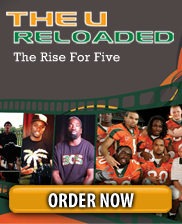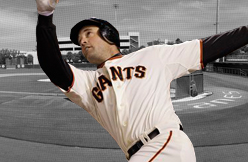I played some part of 15 seasons professionally, so I have had a lot of teammates. Most of whom were major league players, a few of whom were the best in the world. But no teammate could reduce major leaguers into jealous green globs of envy like Pat Burrell.
From the time he walked into a major league clubhouse, he had an uphill climb. Maybe it was his Golden Spikes award, maybe it was having the nickname "Pat the Bat" before he took one major league swing, maybe it was because few players look like they could be both on the cover of GQ and on the cover of Sports Illustrated.
He also walked in chest high, with a swagger, something that old-school players grumbled about. But just like Jimmy Rollins, he was part of Rookie 2.0. Once I embraced the dynamic duo, I would call them "PB & J." Can't beat 'em, join 'em. They came with the confidence that the big leagues was where they belonged from day one; they played with a certain kind of freedom. Burrell was drafted, signed a big league deal right out of the gate and was taking batting practice with the big club from the jump. That wasn't his fault, that was the time. Signing a major league deal and taking batting practice with a major league team came in the negotiations. Certainly, when I was signed by the Cubs as a first-rounder in 1991, I didn't even get a ticket to Wrigley for a press conference.
I remember watching Burrell's first batting practice and hearing the whispers around the field. His swing: "He hits with a lot of top spin." His image: "He kind of reminds me of any good-hitting first baseman with no glove." He was already eroding locker room goodwill, just for taking BP. All eyes were on him.
Then the real game began and he became more than the first-round draft pick on a joy ride; he became a teammate, my left fielder. He came off a spring training, where he truly looked like he was on his way. Dominating the game, hitting to all fields, hitting for power and average. It was the first moment when we all finally said, "OK, I see why they thought this guy was good."
But such is the path of the No. 1 pick in the country. Pat was one of the pioneers of draft picks who had a very public following before the ink dried on his pro contract, and I knew with the power came a huge burden. It made it more difficult for big league teammates to think of him outside of the privileges he had without paying for them with long-term minor league blood, sweat, and tears. So it became easier to simplify Pat and decide that everything was hype and flashes of brilliance. So Pat had to keep swinging.
Once he arrived in Philadelphia, one of the toughest cities to play for on earth, he came with a mountain of expectation. On the surface, he looked like he could shrug it off, that he belonged here, that this was his destiny. But when I had a chance to really talk to him, he saw it as something he had to seize and enjoy, and not take it for granted. In fact, he was very sensitive to the criticism, knowing that he had to overcome plenty of personal challenges to handle this opportunity.
I watched him become one of the hardest-working outfielders I ever played with. When you are a center fielder, you know the body language of your corner outfielders. Slumping corner outfielders work on their swing or stare into space after a foul ball. Pat stayed locked in on every pitch, and this was coming from a player who was getting knocked for having no real position when he broke in.
The conversation about Pat slowly started to shift on the team. Coaches now had to slow him down because he would throw so much in practice that they were worried he would hurt his arm. He was relentless at working on that ball down the left-field line when he was trying to cut off and throw the runner out at second base. He got so good at it that I looked forward to seeing which baserunner would test him. He was so accurate that he hardly ever missed.
I played with faster outfielders than Pat, but few worked as well with me. He always paid attention to where I had to position him for the hitter, always knew the situation, and if he had something to add, he respectfully suggested something else. Hustle was never an issue. If he didn't get to a ball, it was simply because he couldn't.
Even when the money rolled in, he was still working out there. The Phillies offered him a contract right after the first breakout year. All the armchair GMs (composed of both players and fans) came alive talking about how the organization couldn't wait to throw money at him. They decided he hadn't done it for long enough. Even if that was true, that wasn't his fault. He kept working on that ball down the left-field line.
He also had to endure the jealousy and voyeurism around his social life, often more of a topic than his game. Certainly, he loved to get after the nightlife and seemed to be in a vicious circle between self and being in character (I called him "Ray Liotta" on a few occasions). Just as most players with his kind of access. But his name was daily tabloid fodder and everyone knew the fame level of his date before they did his batting average. Nothing was more interesting than when his Hollywood ex-girlfriend sang the national anthem when we were playing the Dodgers. He took a lot of heat about that one. From me, in particular.
Even then, there were reasons given for his "success" off the field. His hair, his height, the money, the big league uniform. There was nothing he actually earned, even when he earned it, and at times, I knew that bothered him.
When I was living in Chicago, I was watching a Cubs game with a friend when Pat was playing against them. My friend said, "What has he done? Nothing. He just keeps getting paid." So, I corrected him. "Actually, he has done a lot more than you think." So I pulled up his stats and my friend said, "That is a lot better than I thought." Sure, he had the one horrible year, he struck out a lot, but he drove in his runs, he got on base and he played hard.
"He could be doing more, but he is doing more than you thought." That was how Pat came into the game and how the peak of his earning years ended up. But he closed it out in fine fashion, even with releases and demotions. He still brought home three rings, two from championships and one from his wedding. Sure he struggled mightily at times and some took joy in seeing him get knocked down a few pegs, but from my vantage point, Pat very much understood that he had to work at what everyone thought he was given.

(espn.com)



